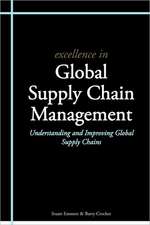Inventory and Production Management in Supply Chains
Autor Edward A. Silver, David F. Pyke, Douglas J. Thomasen Limba Engleză Hardback – dec 2016
| Toate formatele și edițiile | Preț | Express |
|---|---|---|
| Paperback (1) | 271.37 lei 3-5 săpt. | +68.88 lei 4-10 zile |
| Taylor & Francis – 30 sep 2021 | 271.37 lei 3-5 săpt. | +68.88 lei 4-10 zile |
| Hardback (1) | 712.04 lei 6-8 săpt. | |
| Taylor & Francis – dec 2016 | 712.04 lei 6-8 săpt. |
Preț: 712.04 lei
Preț vechi: 837.69 lei
-15% Nou
Puncte Express: 1068
Preț estimativ în valută:
136.26€ • 147.96$ • 114.46£
136.26€ • 147.96$ • 114.46£
Carte tipărită la comandă
Livrare economică 22 aprilie-06 mai
Preluare comenzi: 021 569.72.76
Specificații
ISBN-13: 9781466558618
ISBN-10: 146655861X
Pagini: 810
Ilustrații: 95 Tables, black and white; 109 Illustrations, black and white
Dimensiuni: 178 x 254 x 53 mm
Greutate: 1.62 kg
Ediția:4th edition
Editura: Taylor & Francis
Colecția CRC Press
Locul publicării:Oxford, United Kingdom
ISBN-10: 146655861X
Pagini: 810
Ilustrații: 95 Tables, black and white; 109 Illustrations, black and white
Dimensiuni: 178 x 254 x 53 mm
Greutate: 1.62 kg
Ediția:4th edition
Editura: Taylor & Francis
Colecția CRC Press
Locul publicării:Oxford, United Kingdom
Public țintă
Professional Practice & DevelopmentCuprins
The Context and Importance of Inventory and Production Management. Replenishment Systems for Managing Individual Item Inventories within a Firm. Managing Inventory in Multiple Locations and Multiple Firms. Production Management.
Notă biografică
Edward A. Silver, David F. Pyke, Douglas J. Thomas
Descriere
Authored by a team of experts, the new edition of this bestseller presents practical techniques for managing inventory and production throughout supply chains. It covers the current context of inventory and production management, replenishment systems for managing individual inventories within a firm, managing inventory in multiple locations and firms, and production management. The book presents sophisticated concepts and solutions with an eye towards today's economy of global demand, cost-saving, and rapid cycles.
It explains how to decrease working capital and how to deal with coordinating chains across boundaries.
























